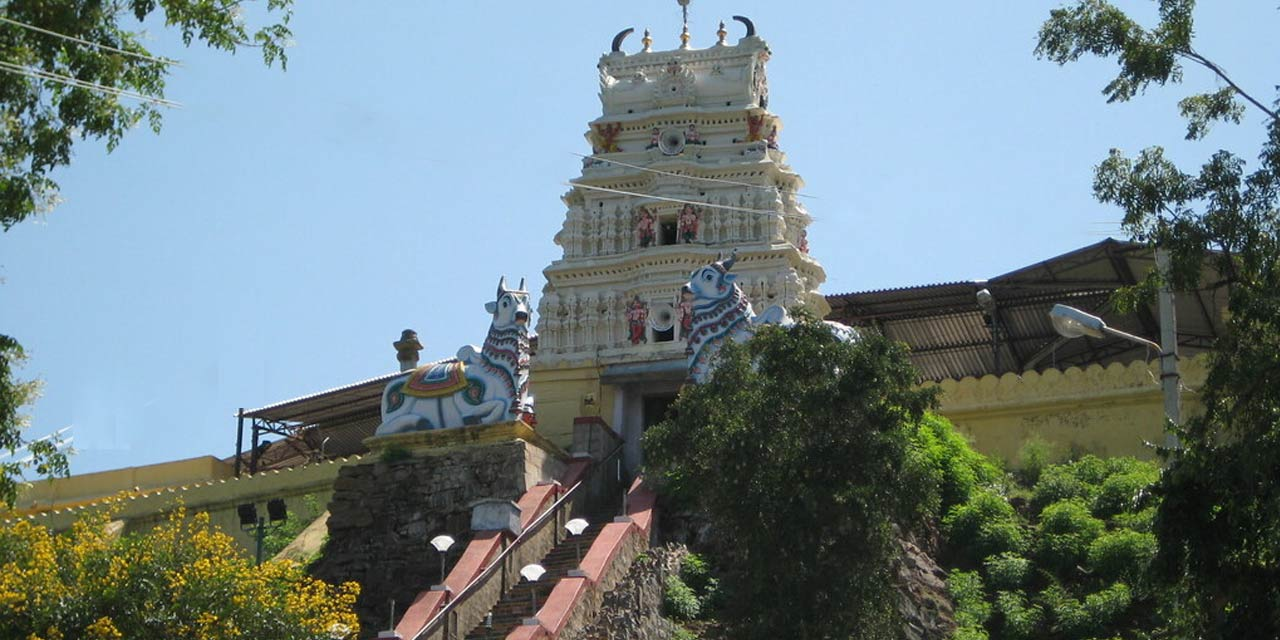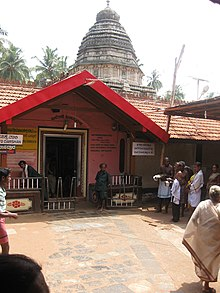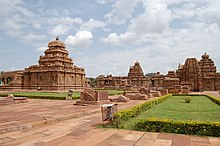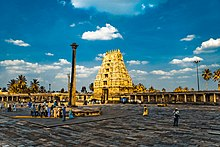Glimpse of Fascinating Pilgrimage Temples in Karnataka
- Dharmastala
- Chamundi Hills
- Nanjanagudu Shri Srikanteshwara Swami Temple
- Murudeshwara
- Mahadeshwara Betta
- Talakadu
- Mudukuthore Malikarjuna Swamy Temple
- Kotilingeshwara Temple
- Melukote
- Kukke Subramanya
- Srirangapatna
- BR Hills
- sringeri
- Udupi
- Gokarna
- patadakal
- Chenakeshva Temple
- Kedareshwara Temple
- kanaka Durga
- Virupaksha Temple
The Dharmasthala Temple is a beautiful, historic temple that is 8 centuries old. It is dedicated to the Hindu God, Lord Shiva and is situated in the famous Dakshin Kannada district of the temple town of Dharmasthala.
Named after the Goddess Chamundi, the Chamundeshwari Temple sits atop the main hill. The main hill itself features an ancient stone stairway of 1,008 steps leading to its summit. Approximately halfway to the summit is statue of bull Nandi, the vahana, or "vehicle" of Lord Shiva, which is 4.9 m tall and 7.6 m long and carved out of a single piece of black granite. Around this point, the steps become significantly less steep and eventually the climber is rewarded with a panoramic view of the city.
The Nanjundeshwara Temple is an ancient temple dedicated to Shiva in the Hindu pilgrimage town of Nanjanagudu in Karnataka, India. It is located on the right bank of river Kapila, a tributary of the Kaveri. Nanjangudu is also known as "Dakshina Prayaga" or "Prayag of South"
Murdeshwar Temple was built on the Kanduka Hill which is surrounded on three sides by the waters of the Arabian Sea. It is dedicated to Lord shiva, and a 20-storied Raja Gopura is constructed at the temple in 2008. The temple authorities have installed a lift that provides a view of the 123-feet Sri Shiva idol from the top of the Raja Gopura. There is also a Rameshwara linga at the bottom of the hill, where devotees can do seva themselves. A Shaneswar temple has been built next to the idol of Sri Akshayaguna. Two life-size elephants in concrete stand guard at the steps leading to it. The entire temple and temple complex, including the 209-feet-tall Raja Gopura, is one among the tallest.
The Lord Sri Mahadeshwara is believed to be the incarnation of Lord Shiva. Historical evidences suggest that the Saint Mahadeshwara must have lived during the 15th century. About 600 years ago, he came here to perform penance and it is believed that he is still performing penance in the temple's Garbha Gudi in the form of a Linga. The Linga, worshipped now in the Garbha Gudi, is a self-manifested (swayambhu) one. Sri Male Mahadeshwara Swamy was moving on a tiger known as Huli Vahana (Tiger as a vehicle) and performed a number of miracles around the Betta to save the people and saints living there. The Lord Sri Mahadeshwara's miracles are sometimes sung by the village folk in Janapada Style
Mallikarjuna Swamy Temple is a revered Shiva temple near Mysore. It is one of the five Shiva temples in the region, which are popularly known as the panchalingas. Mallikarjuna Temple is in Mudukuthore, while the other temples are in Talakadu.
Mudukuthore (officially known as Thirumalakudu Bettahalli) is also close to Talakadu. And it is on the banks of the River Kaveri. Mudukuthore has been named so because the river takes a turn here and flows forward. “Muduku” means diversion, and “thore” means flow forward.
Before Kammasandra village was known as "Kammasandra" it was known as "Dharmasthali" and was where Manjunatha Sharma (CE 788-827) aka. Bhakta Manjunatha lived. Bhakta Manjunatha was born in Dharmasthali to a family of Shaiva Brahmins and was always a man of good character, but was an atheist who insulted Lord Shiva ever since he was little. He ran a local wrestling school and participated in vigilantism instead of working in his family's catering business and participating in religious traditions. Later in his life, he realized the divinity of Lord Shiva and became an ardent devotee of Lord Shiva. Then, one day when Bhakta Manjunatha and his family visited the local Lord Shiva temple, a few incidents occurred which were interpreted as bad omens and every single holy deepa (incensed lamp) in the temple premises became unlit. The other temple-goers then accused Bhakta Manjunatha as the cause. Nevertheless, Maharaja Ambikeshwaravarma, a local viceroy for the ruling Rastrakuta Dynasty and another Shaiva devotee, happened to be in attendance when that happened and quickly quelled the mob. He then approached Manjunatha to prove his innocence by making every lamp glow again. Bhakta Manjunatha sang the devotional song Mahaprāņa Deepam composed by Mahārishi Vyasa and made them glow brighter than ever before. Everyone realized that Manjunatha was a changed man and was the greatest devotee of Lord Shiva. He is believed to have insulted Lord Shiva ten million times in his lifetime. Therefore, to acquit himself of his past sins, Bhakta Manjunatha, under the patronage of Maharaja Ambikeshwaravarma and the help of his family, created ten million lingas and consecrated them. Hence the name Kōtilingeshwara, where Kōti means crore and installed them in the area now known as Kōtilingeshwara Temple. The temple structures themselves were built by Swamy Sambhashiva Murthy in 1980. The entire story of Bhakta Manjunatha was captured into a critically acclaimed bilingual feature film titled Sri Manjunatha by producer Nara Jayasridevi and director K. Raghavendra Rao.
Melukote in Pandavapura taluk of Mandya district, Karnataka, in southern India, is one of the sacred places in Karnataka.It is built on rocky hills, known as Yadugiri, Yaadavagiri and Yadushailadeepa, overlooking the Cauvery valley. Melukote is about 51 km (32 miles) from Mysore and 133 km (83 mi) from Bangalore.
Melukote is the location of the Cheluvanarayana Swamy Temple, with a collection of crowns and jewels which are brought to the temple for the annual celebration. On the top of the hill is the temple of Yoganarasimha. Many more shrines and ponds are located in the town. Melukote is home to the academy of Sanskrit Research, which has collected thousands of Vedic and Sanskrit manuscripts.
Early in the 12th century, the famous Srivaishnava saint Sri Ramanujacharya, who hailed from Tamil Nadu, stayed at Melukote for about 12 years. It has thus become a prominent centre of the Srivaishnava sect.
Kukke Subramanya ( Kukke Subrahmaṇya) is a Hindu temple located in the village Subramanya, of Kadaba taluk (Earlier in Sullia taluk) in Dakshina Kannada district, Karnataka, India. In this temple Kartikeya is worshipped as Subramanya, lord of all serpents. The epics relate that the divine serpent Vasuki and other serpents found refuge under Subramanya when threatened by the Garuda. The priests in the temple are Shivalli Madhva Brahmins. The poojas and other daily rituals in the temple are performed as per Madhvacharya's Tantra Sara Sangraha.
The Ranganathaswamy temple, also rendered the Sri Ranganathaswamy temple, in Srirangapatna, in the Mandya district of Karnataka state, India, is dedicated to the Hindu god Ranganatha (a manifestation of the god Vishnu). It is one of the five important pilgrimage sites of Sri Vaishnavism along the river Kaveri for devotees of Ranganatha. These five sacred sites are together known as Pancharanga Kshetrams in South India. Since Srirangapatna is the first temple starting from upstream, the deity is known as Adi Ranga (lit; "first Ranga"). The town of Srirangapatna, which derives its name from the temple, is located on an island in the river Kaveri
The Biligirirangana Hills or Biligirirangan Hills (as referred to in biology and geology) is a hill range situated in south-western Karnataka, at its border with Tamil Nadu (Erode District) in South India. The area is called Biligiri Ranganatha Swamy Temple Wildlife Sanctuary or simply BRT Wildlife Sanctuary. It is a protected reserve under the Wildlife Protection Act of 1972. Being close to the Eastern Ghats as well as the Western Ghats, the sanctuary has floral and faunal associations with both regions. The site was declared a tiger reserve in January 2011 by the Government of Karnataka, a few months after approval from India's National Tiger Conservation Authority.
The name Sringeri is derived from Rishyashringa-giri, a nearby hill that is believed to have contained the hermitage of Rishi Vibhandaka and his son Rishyashringa. In an episode in the Bala-Kanda of the Ramayana, Vasishtha narrates how Rishyashringa brought rains to the drought-stricken kingdom of Romapada.
According to legend, Sri Adi Shankara is said to have selected the site as the place to stay and teach his disciples, because when he was walking by the Tunga river, he saw a cobra with a raised hood, providing shelter from the hot sun, to a frog undergoing labour. Astonished by the place where natural enemies had gone beyond their instincts, he stayed here for twelve years. Sri Adi Shankaracharya also established mathas in the northern (at Jyotirmath, near Badrinath), eastern (at Puri) and western (at Dwaraka) quarters of India.
The Krishna Matha was founded by the Vaishnavite saint Jagadguru Shri Madhvacharya in the 13th century. He was the founder of the Dwaita school of Vedanta. It is believed that Madhwacharya found the vigraha of Shri Krishna in a large ball of gopichandana. As told by Sri Madhvacharya, in his Tantrasara Sangraha, the Vigraha is placed Pashchimabhimukha (facing west). All the other Vigrahas in other Ashta Muthas face west as well. Devotees always have darshan of Lord Krishna through the inner window, known as the Navagruha Kindi & the outer window known as the Kanakana Kindi, which is decorated by an arch named after the great saint Kanakadasa. A statue has also been erected. A similar window covers the immediate front of the Vigraha and is called Navagraha Kindi. It is often mistaken to be the Kanakuna Kindi.
The temple opens at 5:30 hours IST. The unique feature of the temple is that the deity is worshipped through a silver-plated window with nine holes (Navagraha Kindi). The temple also offers prasadam (lunch) at noon and is popularly called Anna Brahma as it feeds a vast number of devotees.
The Mahabaleshwar Temple, Gokarna is a 4th-century CE Hindu temple located in Gokarna, Uttara Kannada district, Karnataka state, India which is built in the classical Dravidian architectural style. It is a site of religious pilgrimage. The temple faces the Gokarna beach on the Arabian Sea. The temple deifies the Pranalinga ("the reality of God which can be captured by the mind") also called Atmalinga or Shiva Linga In legend, it is said that the deity of the temple will bestow immense blessings to devotees, even to those who only glimpse it. Currently the administrative charge of the temple is with an Overseeing Committee under the Chairmanship of Justice BN Srikrishna, a Retired Justice of the Hon'ble Supreme Court of India. It is one of the 275 paadal petra sthalams expounded in the Tevaram, a sacred Tamil Shaivite text written during the 6th and 7th centuries by 63 saints called Nayanars.
Pattadakal, also called Raktapura, is a complex of 7th and 8th century CE Hindu and Jain temples in northern Karnataka (India). Located on the west bank of the Malaprabha River in Bagalakote district, this UNESCO World Heritage Site is 14 miles (23 km) from Badami and about 6 miles (9.7 km) from Aihole, both of which are historically significant centres of Chalukya monuments.The monument is a protected site under Indian law and is managed by the Archaeological Survey of India (ASI)
UNESCO has described Pattadakal as "a harmonious blend of architectural forms from northern and southern India" and an illustration of "eclectic art" at its height. The Hindu temples are generally dedicated to Shiva, but elements of Vaishnavism and Shaktism theology and legends are also featured. The friezes in the Hindu temples display various Vedic and Puranic concepts, depict stories from the Ramayana, the Mahabharata, the Bhagavata Purana, as well as elements of other Hindu texts, such as the Panchatantra and the Kirātārjunīya The Jain temple is only dedicated to a single Jina. The most sophisticated temples, with complex friezes and a fusion of Northern and Southern styles, are found in the Papanatha and Virupaksha temples. The Virupaksha temple is an active house of Hindu worship.
The river Mallaprabha, a tributary of Krishna river cutting across the valley of mountains surrounded and the plains has great importance and place in this history of south India. The origin of this river is from Kanakumbi, Belagavi district in the western ghats region flows towards the eastern side. Just 1 km before reaching pattadakkal it starts flowing from south to north. As per the Hindu tradition, a river that flows in the north direction is also called Uttaravahini
Chennakeshava Temple, also referred to as Keshava, Kesava or Vijayanarayana Temple of Belur, is a 12th-century Hindu temple in, Hassan district of Karnataka state, India. It was commissioned by King Vishnuvardhana in 1117 CE, on the banks of the Yagachi River in Belur also called Velapura, an early Hoysala Empire capital. The temple was built over three generations and took 103 years to finish. It was repeatedly damaged and plundered during wars, repeatedly rebuilt and repaired over its history. It is 35 km from Hassan city and about 220 km from Bengaluru.
Chennakesava (lit, "handsome Kesava") is a form of the Hindu god Vishnu. The temple is dedicated to Vishnu and has been an active Hindu temple since its founding. It is reverentially described in medieval Hindu texts, and remains an important pilgrimage site in Vaishnavism. The temple is remarkable for its architecture, sculptures, reliefs, friezes as well its iconography, inscriptions and history. The temple artwork depicts scenes of secular life in the 12th century, dancers and musicians, as well as a pictorial narration of Hindu texts such as the Ramayana, the Mahabharata and the Puranas through numerous friezes. It is a Vaishnava temple that reverentially includes many themes from Shaivism and Shaktism, as well as images of a Jina from Jainism and the Buddha from Buddhism. The Chennakeshava temple is a testimony to the artistic, cultural and theological perspectives in 12th-century South India and the Hoysala Empire rule.
The Belur temple complex along with the nearby Hindu and Jain Temples at Halebidu have been proposed to be listed under UNESCO World Heritage Sites.
Kanaka Durga Temple is a Hindu Temple dedicated to Goddess Kanaka Durga. The deity in this temple is also popularly referred as Kanaka Durga. The temple is located in Vijayawada, Andhra Pradesh, India on the Indrakeeladri Hills on the banks of Krishna River. Kaalika Purana, Durgaa Sapthashati and other Vedic literature have mentioned about Goddess Kanaka Durga on the Indrakeelaadri and have described the deity as Swayambhu, (self-manifested) in Triteeya Kalpa.
Virupaksha Temple is located in Hampi in the Vijayanagara district of Karnataka, India. It is part of the Group of Monuments at Hampi, designated as a UNESCO World Heritage Site. The temple is dedicated to Sri Virupaksha, a form of Shiva. The temple was built by Lakkan Dandesha, a nayaka (chieftain) under the ruler Deva Raya II also known as Prauda Deva Raya of the Vijayanagara Empire.
Hampi, capital of the Vijayanagara empire, sits on the banks of the Tungabhadra River (Pampa hole/Pampa river). Virupaksha Temple is the main center of pilgrimage (ತೀರ್ಥಯಾತ್ರೆ )at Hampi, and had been considered the most sacred sanctuary over the centuries. It is intact among the surrounding ruins and is still used in worship . The temple is dedicated to Lord Shiva, known here as Virupaksha/Pampa pathi, as the consort of the local goddess Pampadevi who is associated with the Tungabhadra River. There is also a Virupakshini Amma temple (mother goddess) in a village called Nalagamapalle, Chittoor district, Andhra Pradesh, approximately 100 km from Tirupati.






















Comments
Post a Comment